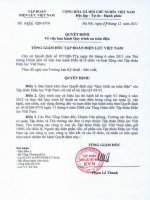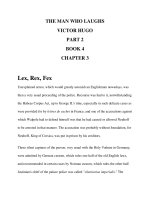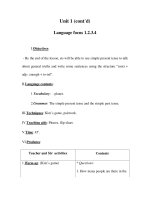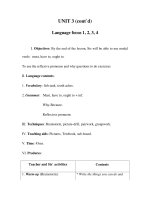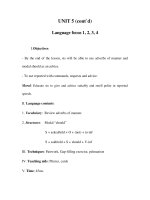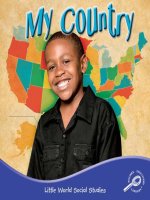4 2 3 geography shapes our world (social studies)
Bạn đang xem bản rút gọn của tài liệu. Xem và tải ngay bản đầy đủ của tài liệu tại đây (23.45 MB, 14 trang )
Suggested levels for Guided Reading, DRA,™
Lexile,® and Reading Recovery™ are provided
in the Pearson Scott Foresman Leveling Guide.
Geography
Shapes
Our World
by Stephanie Sigue
Genre
Expository
nonfiction
Comprehension
Skills and Strategy
• Draw Conclusions
• Graphic Sources
• Answer Questions
Text Features
•
•
•
•
Captions
Glossary
Heads
Maps
Scott Foresman Reading Street 4.2.3
ISBN 0-328-13435-9
ì<(sk$m)=bdedfj< +^-Ä-U-Ä-U
Vocabulary
climate
continents
geography
industry
irrigate
native
Reader Response
Geography
Shapes Our World
1. Give two examples of how geography affects
culture. You can draw your own conclusions and
put them in the form of sentences that you write.
2. Choose two countries that are described here and
compare and contrast them. Use a Venn diagram
to make your comparison.
1st country
2nd country
Both
plantation
products
typhoons
Word count: 1,701
byorStephanie
Sigue
3. Use a thesaurus
book of synonyms
to find as
many synonyms for plantation as you can. When
you have listed all these places for growing
things, use two of them in a sentence.
4. What do you think the author’s purpose was in
writing about a day in the life of these different
children? How did that purpose affect the kinds
of details the author chose to include?
Note: The total word count includes words in the running text and headings only.
Numerals and words in chapter titles, captions, labels, diagrams, charts, graphs,
sidebars, and extra features are not included.
Editorial Offices: Glenview, Illinois • Parsippany, New Jersey • New York, New York
Sales Offices: Needham, Massachusetts • Duluth, Georgia • Glenview, Illinois
Coppell, Texas • Ontario, California • Mesa, Arizona
Geography Shapes Culture
Imagine living by the ocean in Portugal. The
ocean supplies your family with lots of fish to
sell and to eat. But if you live in the grassy plains
of Uruguay in South America, your family may
raise cattle. And if you live in the city of Paris,
you don’t have to depend on what grows in the
area. Food is shipped in from all over the world.
Where you live has a lot to do with how you live.
The Earth is made up of seven different
continents, connected by the Pacific, the Atlantic,
the Indian, and the Arctic Oceans. The continents
are Asia, Africa, North America, South America,
Antarctica, Europe, and Australia. Each continent
has a different climate, geography, and industry.
Let’s take a look at a few!
Every effort has been made to secure permission and provide appropriate credit for
photographic material. The publisher deeply regrets any omission and pledges to
correct errors called to its attention in subsequent editions.
Unless otherwise acknowledged, all photographs are the property of Scott Foresman,
a division of Pearson Education.
Photo locators denoted as follows: Top (T), Center (C), Bottom (B), Left (L), Right (R),
Background (Bkgd)
Cover,7 © Charles & Josette Lenars/Corbis; 6 © Lindsay Hebberd/Corbis; 9 © Richard
List/Corbis; 12 © Jeff Albertson/Corbis; 13 © Juan Medina/COVER/Corbis; 14-15
© Bohemian Nomad Picturemakers/Corbis; 18 © Dave Bartruff/Corbis; 21 © Sandro
Vannini/Corbis
ISBN: 0-328-13435-9
Copyright © Pearson Education, Inc.
All Rights Reserved. Printed in China. This publication is protected by Copyright,
and permission should be obtained from the publisher prior to any prohibited
reproduction, storage in a retrieval system, or transmission in any form by any
means, electronic, mechanical, photocopying, recording, or likewise. For information
regarding permission(s), write to: Permissions Department, Scott Foresman, 1900 East
Lake Avenue, Glenview, Illinois 60025.
4 5 6 7 8 9 10 V0H3 14 13 12 11 10 09 08 07 06
You can find maps like this in an atlas. An atlas provides
information about the world.
3
Aminata in Mali
“Wake up, Aminata!” calls
her mother. Aminata wakes to
another warm, humid day in
Mali. She squats on the floor
with her family and has a simple
but delicious breakfast of maize
porridge. Maize is a kind of corn
that her family grows in a small
plot of land just behind their
house.
After eating, Aminata helps
her mother sweep the floor
and wash dishes. By eight, her
parents leave to work in the
nearby cotton fields. Part of
the money they make pays for
Aminata’s schooling.
Today at school, they are
studying the Dogon people. The
Dogon used to live high in the
cliffs, in protective dwellings
made of pink sandstone. They
now live in the villages, where
life is easier and they are
conveniently closer to the Niger
River.
Mali is the largest
country in West Africa.
4
5
The 21-string kora
Aminata knows how important the Niger River
is. Without it, how would her family irrigate
crops? How would they travel to visit relatives?
When Aminata gets home, she helps her
mother prepare dinner. They grill the perch that
her father caught in the Niger.
After dinner, Aminata’s father plays the kora,
a musical instrument of 21 strings. It’s made of
a gourd that is grown in Mali. The government
prizes this music because it is native and unique.
Her uncle plays the drums. “Drums used to be
played by people to send messages across the
land,” her uncle tells her.
That night, in her bed, Aminata listens to
the crickets outside. Everything here seems to
have a beat that tells a tale, and she wonders
what messages the crickets are repeating to one
another.
This sandstone mosque, a place where
Muslims worship, is in Timbuktu, Mali.
Timbuktu was once a great center of trade
and learning in the Muslim world.
6
7
Maria in Brazil
Maria wakes to noise: beeping cars and loud
conversations. Two out of three Brazilians live in
a city, including Maria and her family, who live
in São Paulo. Right away, Maria gets ready for
school. She’s lucky, because her schooling is free.
Most of Brazil lies south of the equator. From
December to February it’s summer, which is just
one month away. Maria can’t wait! It’s so hot
during that time that most people take vacation,
and school is closed. Maria and her family will go
to the beach and to the five-day Carnival, which
is celebrated all over Brazil.
Today at school, Maria learns about the
Amazon River, which has the most water of any
river in the world. Many people fish here and
hunt along its banks.
In the evening, Maria and her family eat rice,
beans, and fish that her father caught. Brazil
is famous for coffee, and all the adults drink it
throughout the meal.
After dinner, Maria practices a little repitismo
with her mother. It is a kind of call-and-response
singing. “It’s like a conversation,” Maria’s mother
tells her. “In Brazil, music is the way to have a
social gathering of family and friends. This is
very important, especially in the rocky, arid areas
where there aren’t a lot of people.”
By the time Maria goes to sleep, she is very
tired. She thinks of what her mother told her
about how important family
Brazilians eat the
and music are. She’s glad she
foods they grow
has her music and her family
locally. A typical
around her.
Brazilian meal is
arroz, or white
rice, and black
beans and fish.
São Paulo, the
biggest city in
South America
South America is
the fourth-largest
continent in the world.
8
9
Marley in Jamaica
By the time Marley wakes up in Jamaica,
it’s already hot. Jamaica is in the Caribbean, so
the weather is hot most of the year. It’s a good
thing you can cool off on so many of Jamaica’s
white, sandy beaches!
Marley’s parents are getting ready to work
on the sugar plantation. Marley loves sugar
cane because it flavors his favorite breakfast
drink, hot cocoa, made from locally grown
cacao beans.
Marley’s parents prefer to drink coffee.
Jamaica is full of mountains, including the
huge Blue Mountains. Here, the mists create
the perfect soil and climate for growing coffee.
Blue Mountain coffee is famous all over the
world. It’s no wonder Marley’s parents love it.
Jamaica is the largest
of the English-speaking
islands. It is part of a
group of islands called
the Greater Antilles.
10
11
Marley is named after Bob Marley, one of
the most famous musicians in Jamaica. Reggae
is a free-spirited, spiritual music that Bob Marley
made famous. Marley plays the guitar, just
like his famous namesake. “The land inspires
my music to be loud and bright,” say many
musicians, and Marley understands why. Jamaica
is full of colorful flowers, bright blue sky, and
many friendly people.
Marley is lucky, because he goes to school.
Many children in Jamaica don’t. Sometimes in
late fall, when it’s hurricane season, he doesn’t
go to school because the weather is too fierce—
even dangerous—then.
At school, Marley is studying the rivers of
Jamaica. There are more than 120 of them! Is it
any wonder that so many people here love to go
rafting?
School gets out at one o’clock so that children
can help their parents. One of Marley’s jobs is
to help tend the sweet potato crops in the small
garden plot in his backyard.
At dinner, Marley and his family eat cowcod
soup, which is made from bananas and yams.
There is also jerk chicken, which is chicken
marinated in spices and grilled or baked. They
also have sweet potatoes that Marley dug
from their garden. At bedtime, Marley lies in
bed, looks out at the night, and enjoys the
cooling, offshore breeze coming in the window.
Jamaicans call it “the doctor breeze” because it
makes you feel better. Even the breeze, Marley
thinks, has music in it.
Bob Marley
and his band
The Wailers
popularized
reggae music.
Jamaican children
love to play soccer.
12
13
Miko in Japan
The delicious smell of miso soup
wakes Miko, and she gets up from the
straw mat where she sleeps. Japan is
very humid, but these mats keep the
floor cool now, and they will keep the
floor warm in winter.
Her breakfast includes the miso
soup, made from fermented soybeans,
which is one of Japan’s natural
products. After Miko eats, she heads
outside to school. The cherry blossoms
are in bloom! Japan has more kinds of
cherry trees than any other place on
Earth, and when they bloom in April,
everyone celebrates. The blossoms
mean new beginnings. That’s why the
school and business years begin at this
time. Later that evening, Miko and
her family—along with lots of other
families—will go to the park to see
the blossoms. Miko’s mother pickles
the blossoms and makes a delicious
hot drink from them.
In Japan, the roads are so crowded that
many people find it easier to bicycle to work
or to do the daily shopping.
14
15
At school, Miko’s class is
learning about Japan’s geography.
Miko knows that there are many
volcanoes and earthquakes that
cause damage, but the country
has learned to track them. Miko’s
school was even built to be
quake-resistant.
When Miko comes home for
dinner, she takes off her shoes and
puts on soft slippers. Everyone
goes shoeless in the house. For
dinner they are having sushi,
which is raw fish and rice wrapped
in seaweed, and tempura, which is
fish and vegetables fried in batter.
The family talks about what
they will do in the fall. “We’ll go
see Kagura,” Miko’s father says.
The dancers in this elaborate,
traditional ceremony wear fancy
costumes and masks. Kagura was
originally a way to ask for a good
harvest.
Japan has several thousand islands.
Most of Japan is mountains and
hills, so people tend to live in
crowded cities along the coastlines.
16
17
At night, Miko practices the sanshin, which is
something like a banjo. Her grandfather helps
her because he wants to pass down the music
traditions. He tells her that in Okinawa, where
he once lived, the workers used to take their
instruments right into the rice fields. “After work
was done, we would play,” he says. “It made
working so much easier!”
Miko has seen a picture of her grandfather’s
house in Okinawa, where he lived before coming
to live with them. It is surrounded by heavy
stone walls that protected his house from Japan’s
frequent typhoons.
Finally, Miko lies down on her straw mat to
sleep. The lush scent of the cherry blossoms wafts
in through the window and lulls her to sleep.
The sanshin is a traditional three-stringed instrument.
18
Gina in Rome
”Honk! Honk!” A car horn blasts, and Gina’s
eyes fly open. She wakes up in one of the most
famous cities in the world: Rome, Italy.
Gina lives in a large, modern apartment
building with her parents and her grandparents.
Everyone has breakfast together, eating eggs
and toast and cereal. On her way to school Gina
dodges the honking scooters and the rush of
people coming and going, commuting to work.
Gina loves the city. You can walk just about
anywhere, from the Forum to the Spanish Steps.
Her favorite place is by the Coliseum, which is
thousands of years old. And right on the same
block as the Coliseum is a brand-new store selling
fancy shoes. There is a great sense of history
here, but also a sense of modern life. Living in
Rome, the “Eternal City,” Gina can’t help but
appreciate both the past and the present.
These are the ancient ruins of the Temple of Saturn and
19
the Arch of Severus in Rome.
In school, Gina is learning about the dance
Tarantella, which means “spider.” The dance
began long ago as a cure for the spider bite.
Dancers spun around wildly and danced away
the poison!
At dinner that night, Gina’s mother makes
homemade pasta and sauce, which she calls
gravy. They dip freshly-baked bread in olive oil
that is made locally.
After dinner, Gina’s grandfather gives Gina
a music lesson. She is learning to play the
organetto, which is an Italian accordion. “Did
you know the Italians invented musical notation,
the way we set down musical notes on a scale?”
he asks. “That was the beginning of ‘do re mi.’”
Gina is so excited by her grandfather’s stories
that she can hardly go to sleep. Her mind is as
busy as Rome, the city she calls home.
Italy is a warm and sunny
peninsula in southern
Europe, extending into
the Mediterranean Sea.
20
21
Now Try This
You’ve read about a few of the countries of
West Africa, Western Europe, South America,
Asia, and the Caribbean and about some children
who live in them. What do you think your
life might be like if you lived in one of those
countries? You can write a diary page to tell
what your life is like in one of those countries.
to Do It!
w
o
H
s
’
e
r
He
1. Use an atlas. Turn to the maps of Africa,
Europe, South America, Asia, or the
Caribbean, and decide where you might like
to live.
2. After you have chosen a country, use at least
two resources, such as the Internet and books
from the library, to find out more about it.
3. Think about living in one of those countries.
Write a diary page about your day. What is
the geography of your country like? What
happens when you wake up? What happens
in school? Is the weather hot or cold? What do
you eat for breakfast? What sights do you see
during your busy day?
4. Be sure to include some interesting facts in
your report. Don’t forget to tell what people
do for fun. Make your report thorough and
lively.
5. Add visuals to help describe the country.
6. Present your report to the group.
22
23
Glossary
Vocabulary
climate
climate
n. the usual
weather in a place
continents
continents n. seven
large land masses
ofgeography
the earth (Asia,
Africa, Europe, North
industry
America,
South
America, Australia, and
Antarctica)
irrigate
Reader Response
irrigate v. to supply
water to crops by
artificial means, such as
channels and pipes
native n. a person,
animal, or plant that
originally lived or grew
in a certain place
geography n. the study
ofnative
the earth, including
its people, resources,
plantation
climate,
and physical
features
plantation n. a large
farm found in warm
climates where crops
such as coffee, tea,
rubber, and cotton are
grown
industry n.
manufacturing
typhoons
companies
and other
businesses
products n. things
that are manufactured
or made by a natural
process
Word count: 1,701
typhoons n. violent
tropical storms
products
1. Give two examples of how geography affects
culture. You can draw your own conclusions and
put them in the form of sentences that you write.
2. Choose two countries that are described here and
compare and contrast them. Use a Venn diagram
to make your comparison.
1st country
2nd country
Both
3. Use a thesaurus or book of synonyms to find as
many synonyms for plantation as you can. When
you have listed all these places for growing
things, use two of them in a sentence.
4. What do you think the author’s purpose was in
writing about a day in the life of these different
children? How did that purpose affect the kinds
of details the author chose to include?
Note: The total word count includes words in the running text and headings only.
Numerals and words in chapter titles, captions, labels, diagrams, charts, graphs,
sidebars, and extra features are not included.
24


